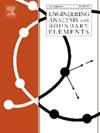Scattering of spherical P-waves by three-dimensional cavity in an elastic half-space
IF 4.2
2区 工程技术
Q1 ENGINEERING, MULTIDISCIPLINARY
Engineering Analysis with Boundary Elements
Pub Date : 2025-02-06
DOI:10.1016/j.enganabound.2025.106137
引用次数: 0
Abstract
This study adopts the indirect boundary integral equation method (IBIEM) to solve the scattering of spherical P-waves by a three-dimensional (3D) cavity in an elastic half-space. Specifically, the free field of the spherical wave is obtained by the method of full space superposition. Based on the single-layer potential theory, the scattered field is constructed using concentrated force sources applied on the fictitious wave source surface. Our method’s numerical accuracy and stability are verified by comparing it against existing results. Additionally, considering a spherical cavity in a half-space as an example, this study investigates the influence of the wave source orientation, incident wave frequency, distance between the wave source and the cavity, and cavity depth on the surface displacement and dynamic stress concentration factor (DSCF) on the cavity surface. The results indicate significant differences in the spatial distribution characteristics of surface displacement and DSCF on the cavity surface for different wave source orientations and cavity depths. As the incident frequency increases, the spatial oscillation of surface displacement near the cavity intensifies, and the DSCF gradually decreases. As the wave source approaches the cavity, the amplification effect of surface displacement near the cavity becomes more apparent. At the same time, the maximum DSCF shows significant non-monotonic variation, and its position also changes accordingly. When the distance between the wave source and the cavity is large, the spherical wave can be approximated as a plane wave.
求助全文
约1分钟内获得全文
求助全文
来源期刊

Engineering Analysis with Boundary Elements
工程技术-工程:综合
CiteScore
5.50
自引率
18.20%
发文量
368
审稿时长
56 days
期刊介绍:
This journal is specifically dedicated to the dissemination of the latest developments of new engineering analysis techniques using boundary elements and other mesh reduction methods.
Boundary element (BEM) and mesh reduction methods (MRM) are very active areas of research with the techniques being applied to solve increasingly complex problems. The journal stresses the importance of these applications as well as their computational aspects, reliability and robustness.
The main criteria for publication will be the originality of the work being reported, its potential usefulness and applications of the methods to new fields.
In addition to regular issues, the journal publishes a series of special issues dealing with specific areas of current research.
The journal has, for many years, provided a channel of communication between academics and industrial researchers working in mesh reduction methods
Fields Covered:
• Boundary Element Methods (BEM)
• Mesh Reduction Methods (MRM)
• Meshless Methods
• Integral Equations
• Applications of BEM/MRM in Engineering
• Numerical Methods related to BEM/MRM
• Computational Techniques
• Combination of Different Methods
• Advanced Formulations.
 求助内容:
求助内容: 应助结果提醒方式:
应助结果提醒方式:


